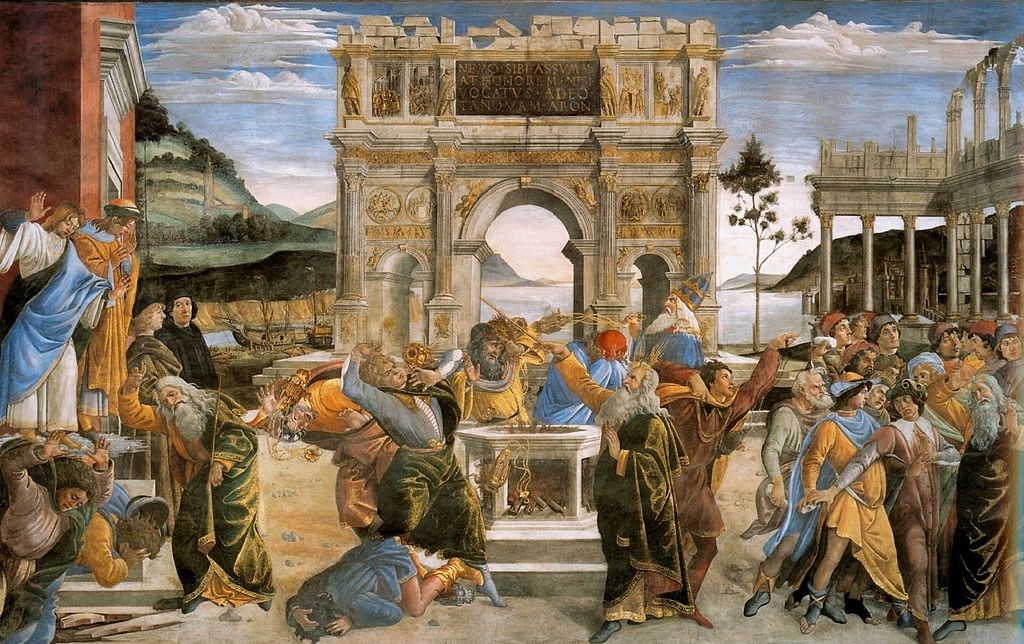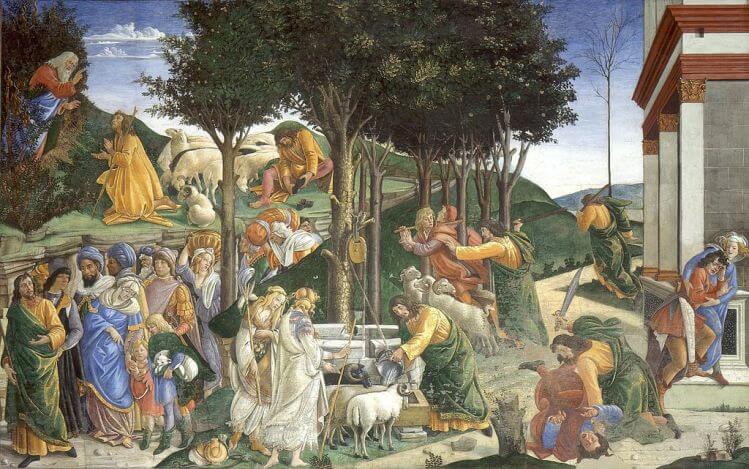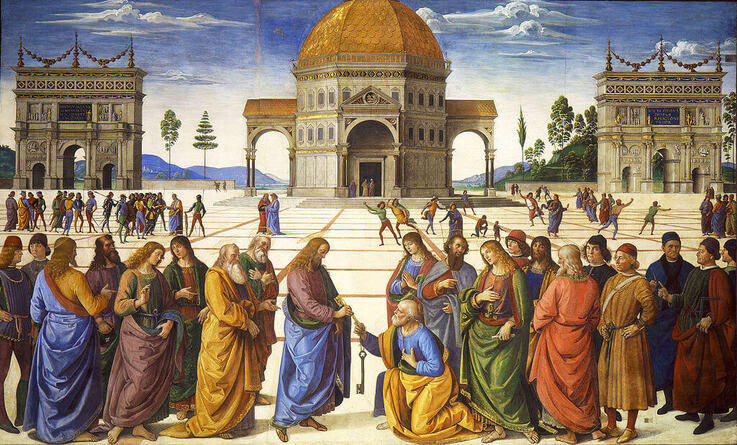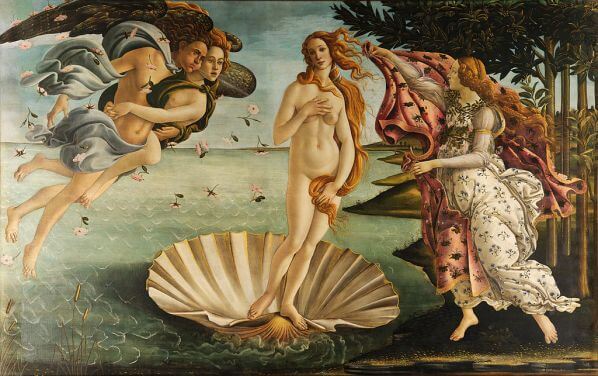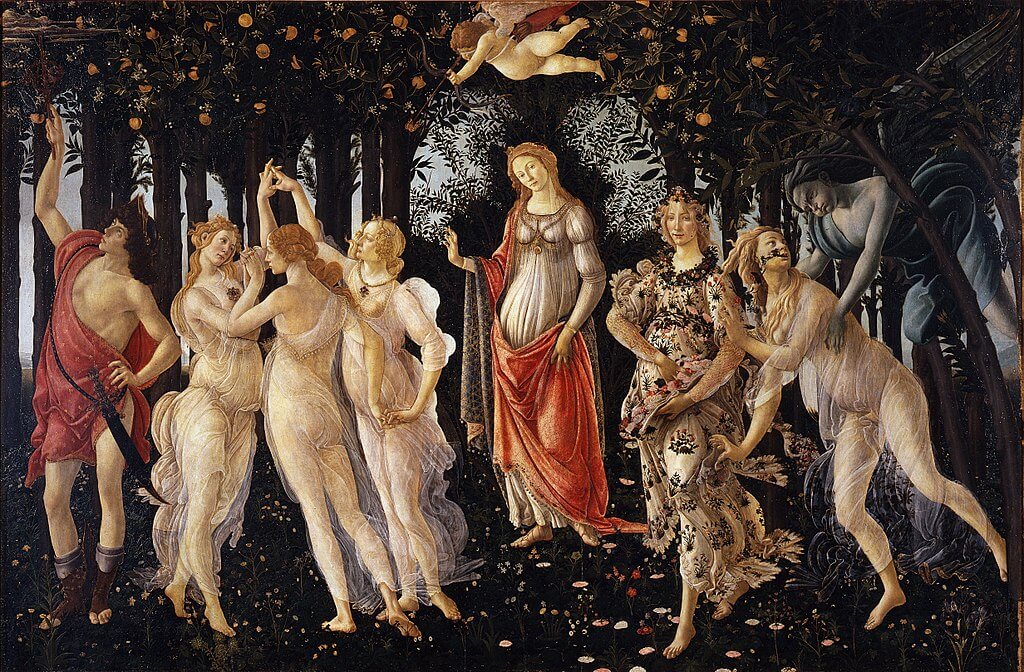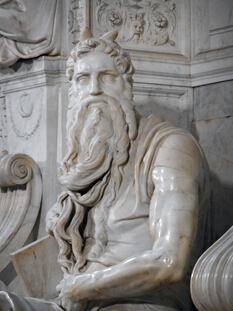|
Where? On the south wall of the Sistine Chapel in the Vatican Museums
When? 1481-1482 Commissioned by? Pope Sixtus IV What do you see? The punishment of Corah (also spelled Korah), Dathan, and Abiram because they opposed the leadership of Moses. There are three different scenes:
Backstory: This painting is part of a series of frescos on the stories of Moses on the south wall of the Sistine Chapel. This series includes another fresco of Botticelli, which is Youth of Moses. The fresco on the Punishments of the Sons of Corah is based on three different stories from the Bible.
What is the Arch of Constantine? It is the largest triumphal arch in Rome. It was built to commemorate the victory in 312 AD of Roman Emperor Constantine I over another Roman Emperor, Maxentius, during a time in which there were multiple emperors in the Roman Empire. The arch is located next to the Colosseum.
The arch is 21 meters (23 yards) high and has three entrances as you can see in this painting. Roman Emperors walked under this arch when they entered the city after a victory. The Arch of Constantine is also depicted twice in the Delivery of the Keys by Perugino which is on the north wall of the Sistine Chapel in the Vatican Museums.
Symbolism: This fresco illustrates the claim of power of the Catholic Church and the papacy. It shows that only priests can perform holy duties and that God will punish people if they do not obey him. It also shows that God saves the people who obey Him. The Arch of Constantine is included to symbolize the victory of Christianity over paganism. The inscription from Hebrews 5:4 shows the holiness of the Pope as he was chosen by God.
Who is Botticelli? Sandro Botticelli was born in Florence in 1445 under the name Alessandro di Mariano di Vanni Filipepi. His father apprenticed Sandro to a goldsmith such that he could soon start making money for the family. As there was a close connection between goldsmiths and painters, Botticelli was able to become familiar with painting and discovered that this was his passion. He became an apprentice of Fra Filippo Lippi, one of the greatest painters of that time. Botticelli is best known for his famous paintings of The Birth of Venus and La Primavera, which are both in the Uffizi Museum.
Written by Eelco Kappe
References:
0 Comments
Leave a Reply. |
Categories
All
|
- Home
- Blog
-
Museums
- Alte Pinakothek
- Art Institute of Chicago
- Baltimore Museum of Art
- Barber Institute of Fine Arts
- Bargello
- Barnes Foundation
- British Museum
- Church of Sant’Anastasia
- Cleveland Museum of Art
- Courtauld Institute of Art
- Detroit Institute of Arts
- Frans Hals Museum
- Galleria Borghese
- Gallerie dell'Accademia
- Getty Museum
- Guggenheim
- Hermitage Museum
- Kunsthistorisches Museum
- Kunstmuseum Basel
- Legion of Honor Museum
- Louvre
- Mauritshuis
- Metropolitan Museum of Art
- Musee d’Orsay
- Museum of Fine Arts in Boston
- Museum of Modern Art
- National Gallery in London
- National Gallery of Art
- National Museum in Poznań
- Norton Simon Museum
- Ny Carlsberg Glyptotek
- Palace of Versailles
- Palazzo Pitti
- Palazzo Vecchio
- Petit Palais
- Philadelphia Museum of Art
- Prado
- Pushkin Museum
- Ravenna Art Museum
- Rijksmuseum
- San Diego Museum of Art
- Santa Maria delle Grazie
- St. Peter's Basilica
- Städel Museum
- Statens Museum for Kunst
- Tate Britain
- Tate Modern
- Timken Museum of Art
- Uffizi
- Vatican Museums
- Wallace Collection
-
Artists
- Altdorfer
- Anguissola
- Berlin Painter
- Bosch
- Botticelli
- Boucher
- Bronzino
- Bruegel the Elder
- Brunelleschi
- Cabanel
- Caillebotte
- Canova
- Caravaggio
- Carpeaux
- Cezanne
- Cimabue
- David
- Degas
- Delacroix
- De Maria
- Donatello
- El Greco
- Fontana
- Fra Angelico
- Fragonard
- Gauguin
- Gentileschi
- Gericault
- Gonzalez-Torres
- Goya
- Hals
- Hogarth
- Hokusai
- Ingres
- Leonardo da Vinci
- Lippi, Filippo
- Longhi, Barbara
- Lorrain
- Makovsky
- Manet
- Massys
- Matisse
- Merian
- Michelangelo
- Mochi
- Modigliani
- Monet
- Panini
- Parmigianino
- Perugino
- Picasso
- Pisanello
- Raphael
- Rembrandt
- Renoir
- Reynolds
- Rivera
- Rodin
- Rubens
- Scultori
- Seurat
- Steen
- Tintoretto
- Titian
- Toulouse-Lautrec
- Turner
- Uccello
- Van der Weyden
- Van Dyck
- Van Eyck
- Van Gogh
- Van Hemessen
- Vasari
- Velazquez
- Vermeer
- Veronese
- Vigée Le Brun
-
Locations
- Books
- About Us

